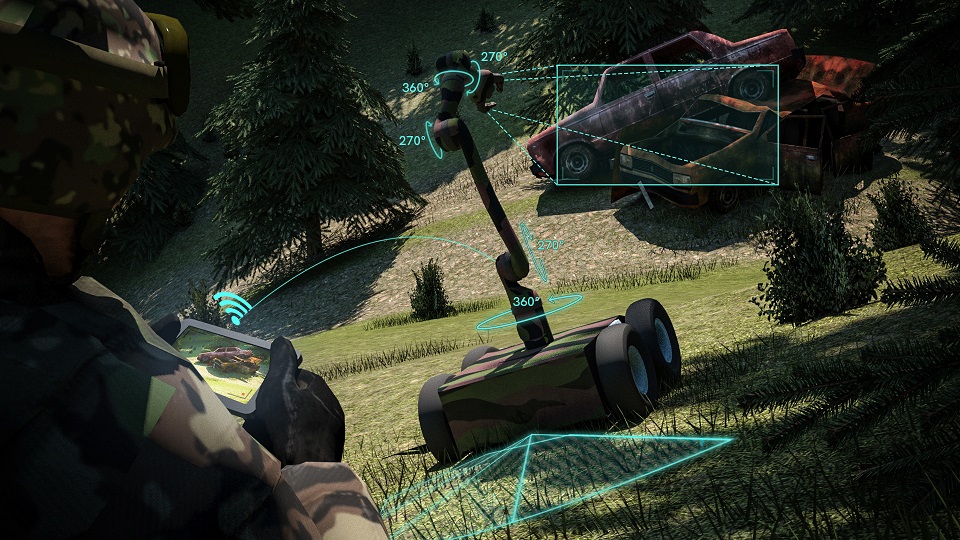This post is also available in:
 עברית (Hebrew)
עברית (Hebrew)
The development processes of autonomous robotic systems require tremendous time and resources for creating a prototype that could teach us about the technology’s capabilities and the quality of its field operations. How will the vehicle operate in challenging terrain? Will it avoid obstacles, etc. Then the prototype returns to the sketching stage for further revisions, a process requiring prolonged development stages.
A ground-breaking and innovative solution of an advanced computer simulation cuts stages and considerably shortens the development time for robots, as well as remotely-operated and autonomous vehicles and aerial systems.
This solution is brought to the Israeli market by Mckit, a subsidiary of Malam Team, Israel’s leading IT company. Mckit has been active in the Israeli market for already 40 years. The company develops advanced, cutting-edge technologies and makes them accessible to the Israeli market – technologies connected with product life cycle management and effectiveness.
The company provides support along the establishment and development process of advanced products and systems, from the idea stage through the prototyping all the way to the end product stage.
Mckit’s activity is designed to introduce to the Israeli market advanced technologies from the wide variety of companies it represents, including 4D-VIRTUALIZ, Bentley, Siemens, and more.

One of the major developments showcased by Mckit, in collaboration with 4D-VIRTUALIZ, is an advanced and innovative platform for real-time simulations and testing, the 4DV-sim platform designed for the simulation of robotic remotely-operated or autonomous vehicles.
The simulation software provides advanced capabilities of environment modeling together with the modeling of vehicles, robots, and aerial systems in a changing environment while cutting development time.
It is an advanced, computerized simulation that enables to see how the vehicle is going to operate on the field, how it will climb and to what height, pass water obstacles, its high temperatures resistance, etc.
The software provides the possibility to test all these parameters in a simulation at the development stage. Further along the road, when the vehicle already exists, the same simulation code can be uploaded to the vehicle platform without any conversions. The result – a substantial reduction in the development time.
Ron Wolfson, a senior director at Mckit, said: “We’re dealing with things that until not long ago were a matter of science fiction. Who could imagine a decade ago that we would have a full working environment that constitutes a simulation of the platform itself and its surroundings and with such high precision? Mckit strives to revolutionize development time reduction and provide the capabilities and tools to enable advancement and technological leap.”
The simulator and software technology incorporates a consistency engine patented by 4D-VIRTUALIZ. The engine manages all information generated during a simulation, enabling a 3D realistic view of the scene and the systems. The 4D-VIRTUALIZ team of engineers and researchers expertizes in remote-controlled and unmanned robotic systems.
How does the technology work? The software creates a digital twin of the real environment. The algorithm development is conducted in the virtual development environment, including capability checking and scenario testing.
The platform provides a full 3D environment, incorporating the graphic presentation of operations and measurement results, e.g. engine parameters, temperature, etc. It provides a multi-sensor situational awareness through what can be seen from inside the vehicle or through a drone.
The software is suitable for challenging off-road terrain as well as for urban environments. The platform enables the evaluation of various scenarios and provides the envelope for operations and capabilities, in accordance with the changing terrain conditions.
The platform enables the development, testing, verification and validation of algorithms. In any case of discrepancy between the simulation and actual operation in the field – the simulation can be corrected and the model can be calibrated to match reality, aiming to reach a 100% matching between the simulation and the physical model (calibration and tuning). Moreover, the platform enables hardware in the loop simulations. For example, it can visualize what is happening when the vehicle driver or remote operator physically pushes the gas pedal even before the complete vehicle actually exists.
The simulation platform applies a plug & play technology – meaning that the same algorithm is used in the simulation and in the actual systems, with a simple and agile transformation from the virtual to the physical model, without any need for any adaptations or conversions.
To Summarize, Mckit’s advanced simulation technology is certainly good news for the robotic systems development process – a considerable reduction in time and resources along the development and implementation process.


























